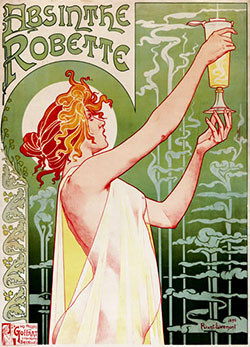|
Absinthe is a highly alcoholic botanical spirit, whose primary ingredients are grand wormwood, green anise, and sweet fennel. Due to the natural green color of early absinthes, the spirit is commonly referred to as la fee verte ("the green fairy"). Absinthe originated in late 18th century Switzerland, and became famous in late 19th century France. Due to its popularity among radical artists and intellectuals, absinthe was vilified as the cause of unconventional ideas and a threat to the established order. Absinthe was falsely portrayed as an addictive psychoactive drug and banned throughout the Western world in the early 20th century. It became legal again in the early 21st century, had its reputation tarnished by saturation marketing of inferior brands, and is now experiencing a quiet renaissance among craft distillers. Famous absinthe drinkers include Vincent Van Gogh, Ernest Hemingway, Aleister Crowley, Charles Baudelaire, and Oscar Wilde.
"Real" Absinthe
Thujone, a chemical present in grand wormwood, was once thought to be a psychoactive ingredient in absinthe, although this has been disproved. The original absinthes that were banned 100 years ago had thujone levels of 5 Parts Per Million or less. Absinthes produced for consumption in the European Union are limited to 35 Parts Per Million of thujone. Absinthes produced for consumption in the United States are limited to 10 Parts Per Million of thujone. Absinthes produced in the Czech Republic and other parts of Eastern Europe have no such limits, and often contain much higher levels of thujone, sometimes as high as 100 Parts Per Million. Unfortunately, thujone is not the exciting hallucinogen some think it to be, and absinthes produced with the intent of a high thujone content are generally atrocious products that nobody in their right mind would ever want to drink. It remains fairly common for those inexperienced with absinthe to dismiss the exceptional spirits available in the United States as "not real absinthe", and seek out the bitter and artificial Czech variety instead - this is a constant source of amusement to connoisseurs, who recognize this behavior as the equivalent of passing over tender filet mignon in favor of a rubbery hot dog.
How To Drink It
Because of the extremely high alcohol content of absinthe, it is generally diluted with cold water before being consumed. The most elegant traditional method of preparing absinthe is to use an absinthe fountain to slowly drip cold water into the glass, over a slotted absinthe spoon holding a sugar cube. The sugar cube is necessary in the case of bitter absinthes of lower quality, but unecessary in the case of many of the more balanced absinthes.
Why It Clouds Up
One measure of the quality of an absinthe is the transformation it undergoes when mixed with water. As the oils in the absinthe come out of solution, they form a swirling cloud, in tones of white and green, that eventually overtakes the entire spirit. This cloud is called the louche ("opaque"), and as it forms, the absinthe reveals subtle flavors that were previously hidden. Some absinthe drinkers prefer their absinthe neat, treating it like a cask strength herbal whiskey. Most absinthe drinkers prefer the classic ritual with the fountain, treating the louched absinthe like a botanical wine. It is all a matter of personal taste.
Lighting It On Fire
The Bohemian style of preparing absinthe by lighting it on fire, contrary to popular belief, originated not in the 1800s, but in the 1990s. The Bohemian method was invented by Czech marketers as a means of making poor quality absinthe sexier to a crowd seeking a cheap drug instead of an elegant spirit. At Risky Business we are not above using the Bohemian ritual with our well absinthe, because it is a fairly sexy way to drink, but please don't ask us to burn any of the good stuff.
Types of Absinthe
The most common variety of absinthe is known as verte ("green") for its peridot green hue. The color comes from the botanicals that also produce its vibrant flavor. Absinthes called blanche ("white") or la bleue ("bluish") are clear. These clear absinthes were originally developed in Switzerland to be easier to smuggle, due their lack of telltale green color, but are now a popular variety in their own right. Spanish absinthes, referred to as absenta, tend to use slightly different ingredients than their French and Swiss counterparts, and often have a sharper flavor with notes of citrus. Some of the oddest abinsthes are rouge ("red") or rose ("pink"), sporting a bright red or soft pink hue resulting from the inclusion of hibiscus flowers or the juice of an insect called a cochineal.
Absinthe Adventure
The fourth Sunday of every month is Absinthe Adventure at Risky Business, featuring specials on absinthe tasting flights and cocktails. If you would like to be introduced to the green fairy, or are coinosseur interested in sampling some varieties or cocktails you may not be familiar with, this is the event.
Bottle Service
If you are seeking a truly unique experience to share with friends, we offer a number of extraordinary absinthes by the bottle, with an exquisite fountain at your table, and instruction by our charming bartenders. You should have a party of 8 to 16 people to split 1 bottle of absinthe. Prices range from $250 to $400 for the entire bottle service, and we can help with other arrangements, such as local food, to make the event special.
Contact Risky Business
|
 |